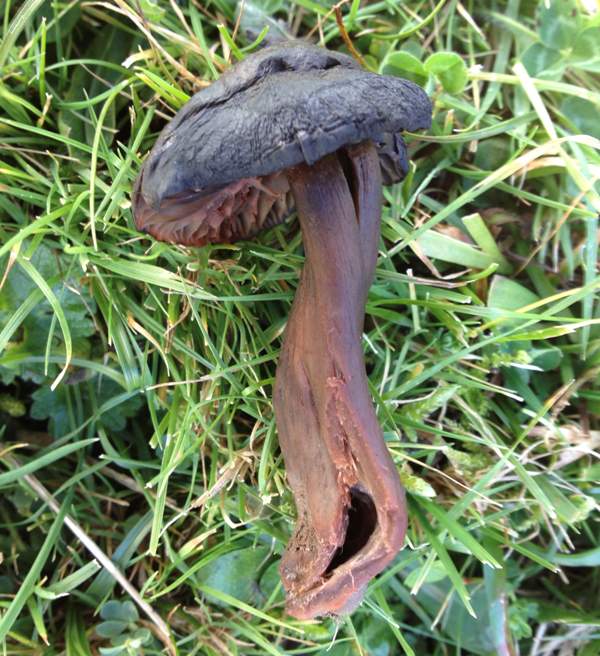Trees Birds Mammals Fish Amphibians Reptiles
Wild Algarve
Bookshop
Hygrocybe ovina (Bull.) Kuhner - Blushing Waxcap
Phylum: Basidiomycota - Class: Agaricomycetes - Order: Agaricales - Family: Hygrophoraceae
Distribution - Taxonomic History - Etymology - Identification - Culinary Notes - Reference Sources

Many of the colourful waxcap mushroom species can be tricky to identify, but with its dry blackish cap, pink-bruising gills and smooth stem, this nitrous-scented waxcap is one of the most distinctive. Unfortunately, because of its scarcity in Britain and Ireland few people get the opportunity to become familiar with the Blushing Waxcap.
Distribution
The Blushing Waxcap is a very rare find in Britain and Ireland. This species occurs also in most European countries but it is either uncommon or rare throughout this range. In Canada and parts of the USA, Hygrocybe ovina is an occasional find in some mixed woodlands.
Taxonomic history
When pioneering French mycologist Jean Baptiste Francois Pierre Bulliard described this waxcap mushroom scientifically in 1793 he gave it the name Agaricus ovinus. (At that time most gilled fungi were initially placed into the genus Agaricus, since cut down to a more manageable proportions by redistribution of most of its contents to other genera, including Hygrocybe.) It was German mycologist Robert Kuhner (1903 - 1996) who, in 1926, transferred this species to the genus Hygrocybe, establishing its current scientific name Hygrocybe ovina.
Hygrocybe ovina has several synonyms including Agaricus ovinus Bull., Hygrophorus ovinus (Bull.) Fr., Camarophyllus ovinus (Bull.) P. Kumm., Neohygrocybe ovina (Bull.) Herink, Hygrophorus nitiosus A. Blytt, and Hygrocybe nitiosa (A. Blytt) M.M. Moser.
Etymology
The genus Hygrocybe is so named because fungi in this group are nearly always very moist (although Hygrocybe ovina is one of the few exceptions). Hygrocybe means 'watery head'. The specific epithet ovina is a Latin adjective relating to sheep, indicating that this waxcap mushroom can be found in places where sheep graze.
Identification guide
| |
Cap
The dry dark grey-brown to blackish cap is at first hemispherical or campanulate with an inrolled margin and then becomes irregularly conical or broadly convex, usually 2 to 9cm in diameter, becoming cracked, pitted or squamulose. The cap flesh is thin and reddish-orange. |
| |
Gills
Sepia grey to grey brown but usually significantly paler than the cap surface, the dry, broad and thick gills are adnexed and moderately spaced.
Stem
Concolorous with the cap or somewhat paler, the smooth dry stipe is usually hollow, furrowed and laterally compressed, fusiform or with a clavate base, 0.7-2.5cm in diameter and 3-12cm long; no stem ring; stem flesh slightly paler than the surface, blushing reddish when cut. |
| |
Spores
Ellipsoidal to sublacrymoid, smooth, 7.5-9 x 5-6μm; inamyloid.
Spore print
White. |
Odour/taste |
Odour slightly nitrous, and old fruitbodies may smell unpleasant; taste not distinctive. |
Habitat & Ecological role |
In unimproved grassland including lawns and churchyards where artificial fertilisers are not spread; also sometimes among Heather Calluna vulgaris on acidic heathland.
Waxcaps have long been considered to be saprobic on the dead roots of grasses and other grassland plants, but it is now considered likely that there is some kind of mutual relationship between waxcaps and mosses. |
Season |
July to October in Britain and Ireland. |
Similar species |
Hygrocybe conica turns black with age or when cut; its stem does not turn red when cut or bruised. |
Culinary Notes
The Blushing Waxcap is rare and should not be collected other than for scientific study.
Reference Sources
Fascinated by Fungi, 2nd Edition, Pat O'Reilly 2016, reprinted by Coch-y-bonddu Books in 2022.
Fungi of Northern Europe, Volume 1 - The Genus Hygrocybe, David Boertmann, 2010.
Dictionary of the Fungi; Paul M. Kirk, Paul F. Cannon, David W. Minter and J. A. Stalpers; CABI, 2008
Taxonomic history and synonym information on these pages is drawn from many sources but in particular from the British Mycological Society's GB Checklist of Fungi.
Acknowledgements
This page includes pictures kindly contributed by Tony Raw.
Top of page...
Fascinated by Fungi. Back by popular demand, Pat O'Reilly's best-selling 450-page hardback book is available now. The latest second edition was republished with a sparkling new cover design in September 2022 by Coch-y-Bonddu Books. Full details and copies are available from the publisher's online bookshop...